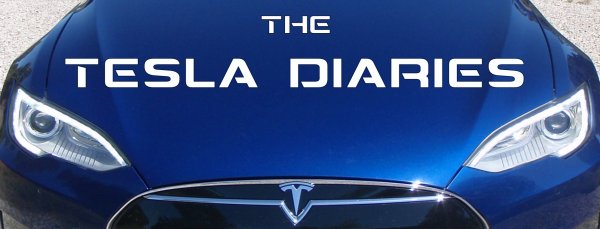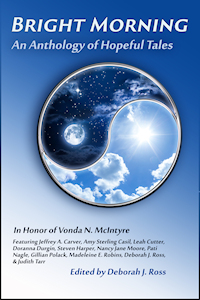
(This post is part of a blog series. In case you haven’t read it, here’s the first post.)
When you first get your Tesla, the touchscreen asks you to enter its name. We had entered Nikola, so having that for the plate made us that much happier.
It took a few weeks to get the hang of driving Nikola around town and on short trips in-state. We traded stories about our experiences every day: not only Tesla moments, but moments of discovery. “Did you know Nikola can do this?”
We joined the New Mexico Tesla Owners club (which is also open to interested non-owners), and had fun meeting other owners for group lunches and trading stories. It’s fun to see a dozen or more Teslas parked in a line together.
By the time the date arrived for our planned overnight trip to Winslow, Arizona, we were fairly comfortable driving the car … but this was different. We’d be going about 280 miles, more than our range on a single charge.
Range Anxiety reared its ugly head.
When you’re driving an ICE (internal combustion engine) car, you mostly don’t have range anxiety, because there are gas stations everywhere. If you happen to get careless and run out of gas, you can call for help or walk to a gas station.
Electric car owners are more susceptible to range anxiety, although they really don’t need to be. After all, there are even more electrical outlets than gas stations in the world. Regular house current is pretty slow, though. A 220 outlet or better is needed for anything more than a trickle of charge, and for a Tesla, the fastest available charge comes from a Tesla Supercharger.
At the time we got Nikola, there were three Supercharger stations in New Mexico: one in Albuquerque, one in Las Vegas (not on our route), and one in Gallup (on our route). The Albuquerque Supercharger wouldn’t be much help, because our battery would still be pretty full when we reached Albuquerque. So we’d have to charge in Gallup, 138 miles from Albuquerque.
In theory, our 85 kWh battery has a range of about 270 miles. In practice, it’s closer to 240 or 250. But running the heater cuts into that, and it was January. Also, if we used up all the battery charge, we could “brick” the car and end up stranded. Arranging towing for a 2.5-ton vehicle is a bit complicated, and while Tesla has mobile service available, the nearest source to us was in El Paso, 266 miles south of Albuquerque.
Now, the touchscreen has a navigation feature that helps you plan your drive to any destination. You tell it where you want to go, and it tells you where you need to stop and charge, and estimates how long it will take to charge enough to go the next leg. We knew this, but knowing something intellectually and understanding it viscerally are two different things.
The touchscreen also has an energy consumption feature, which guestimates your current range based on your most recent consumption. This estimate varies wildly, especially if you drive up and down mountain roads*. But we didn’t know that at the time, so it kind of freaked us out.
Long story short, we were nervous about running out of juice. We tiptoed out of Albuquerque at the speed limit. ICE cars zoomed past us.
Once we reached Gallup without trouble, we relaxed a bit. The Supercharger there is in the parking lot of a hotel, whose staff was friendly. We sat in their lobby, had coffee, and watched the news while the car was charging. After fifteen or twenty minutes, we figured we had enough charge to get to Winslow, or at least to Holbrook, where there’s another Supercharger, so we got back on the road.
Why didn’t we stay to top up the battery to a full charge? Because the closer a Tesla battery pack gets to being full, the slower it charges. It seems counter-intuitive, but the best strategy is actually to charge only as much as you need to get to the next Supercharger.
We continued to drive at a moderate speed, but we no longer felt as anxious about making it to Winslow. We kept an eye on the distance remaining and the charge remaining, dithering about whether to stop in Holbrook. Finally, we decided to skip it. We’d be pretty low when we got to Winslow, but we’d be charging overnight, so we’d have a full battery for the trip home.
I took the wheel for the last leg into Winslow. It’s a straight shot on westbound I-40. Nothing remarkable. Since we were feeling a bit more relaxed, I drove a little faster.
One thing we didn’t realize: the last few miles into Winslow coming from the east are uphill.
It was afternoon by now, and in the Southwest, days can get warm even in winter. We turned on the air conditioner to counter the hot sunlight.
Soon we noticed that our comfortable safety margin for getting to Winslow was decreasing. Yikes!
When your battery drops below 20%, your Tesla starts giving you range warnings. The green line on your mileage estimate graph turns yellow. The car suggests you find a place to charge soon. And if the charge drops low enough, the car starts shutting down “luxuries” like heating or air conditioning, and limiting your speed.
I dropped back down to the speed limit, and turned the thermostat up. The last mile or so into Winslow was a little tense, but really, we were in no trouble. Like many things about this new technology, we just needed to experience a low-charge situation to really understand it.
We reached La Posada with about 17% charge left. The hotel has two destination chargers. We plugged into one and unloaded our luggage, paused for a Tesla moment with some people in the parking lot, then went into the hotel and checked in.
On the way home the next day, we did better. Less anxiety, for sure. It was safest to drive at a moderate pace, which was actually relaxing. We have since found that to be true on all of our long distance trips. We let the ICE cars roar by if they want to, and take our time.
Now, all of this happened without Autopilot, because we had decided against buying it when we were designing the car. We apparently weren’t alone in that, because in May, we got a message from Tesla offering us a one-month free trial of Autopilot.
Want to taste the Koolaid? The first cup is free…
*Like many hybrids, Teslas have regenerative braking, which puts energy back into the battery when braking. This happens automatically when you are driving downhill with the cruise control set, for example. It can result in unrealistic range estimates on the energy consumption page.
Tesla has again updated their referral offer! If you use a referral code from an existing Tesla owner, like this one: http://ts.la/pat9663 (good for five referrals, after which it expires) to order a new Model S or Model X, you will be eligible for free Supercharging as long as you own your Tesla. The same code is also good for a 5-year extended limited warranty on a new solar energy system installation. This offer ends April 30, 2018.







I very much enjoyed reading about your Tesla adventures to date. We purchased our 2014 Leaf three years ago. The Leaf, obviously, had far fewer features to learn about but I found the similarity between your experience and ours striking. Just goes to show how the transition from ICE to EV is a moving experience regardless of the model purchased. Thanks for sharing.
Thanks for commenting, Tom! Yes, the transition to EV is definitely a revelation. I look forward to watching many more people make this shift in the next few years.
We feel completely spoiled now, of course. Never going back to ICE. We’ll be replacing our remaining ICE car with an EV Real Soon Now.